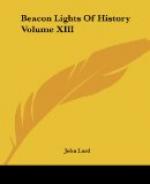In respect of early recognition and popularity, Carlyle differs from his great contemporary Macaulay, who was so immediately and so magnificently rewarded, and yet received no more than his due as the finest prose writer of his day. Macaulay’s Essays are generally word-pictures of remarkable men and remarkable events, but of men of action rather than of quiet meditation. His heroes are such men as Clive and Hastings and Pitt, not such men as Pascal or Augustine or Leibnitz or Goethe. But Carlyle in his heroes paints the struggling soul in its deepest aspirations, and the truths evolved by profound meditations. These are not such as gain instant popular acceptance; yet they are the longer-lived.
The time came at last for Carlyle to leave his retirement among moors and hills, and in 1831 he directed his steps to London, spending the winter with his wife in the great centre of English life and thought, and being well received; so that in 1834 he removed permanently to the metropolis. But he was scarcely less buried at his modest house in Chelsea than he had been on his farm, for he came to London with only L200, and was obliged to practise the most rigid economy. For two years he labored in his London workshop without earning a shilling, and with a limited acquaintance. Not yet was his society sought by the great world which he mocked and despised. He fortunately had the genial and agreeable Leigh Hunt for a neighbor, and Edward Irving for his friend. He was known to the critics by his writings, but his circle of personal friends was small. He was more or less intimate with John Stuart Mill, Charles Austin, Sir William Molesworth, and the advanced section of the philosophical radicals,—the very class of men from whom he afterwards was most estranged. None of these men forwarded his fortunes; but they lent him books, and helped him at the libraries, for no carpenter can work without tools.




